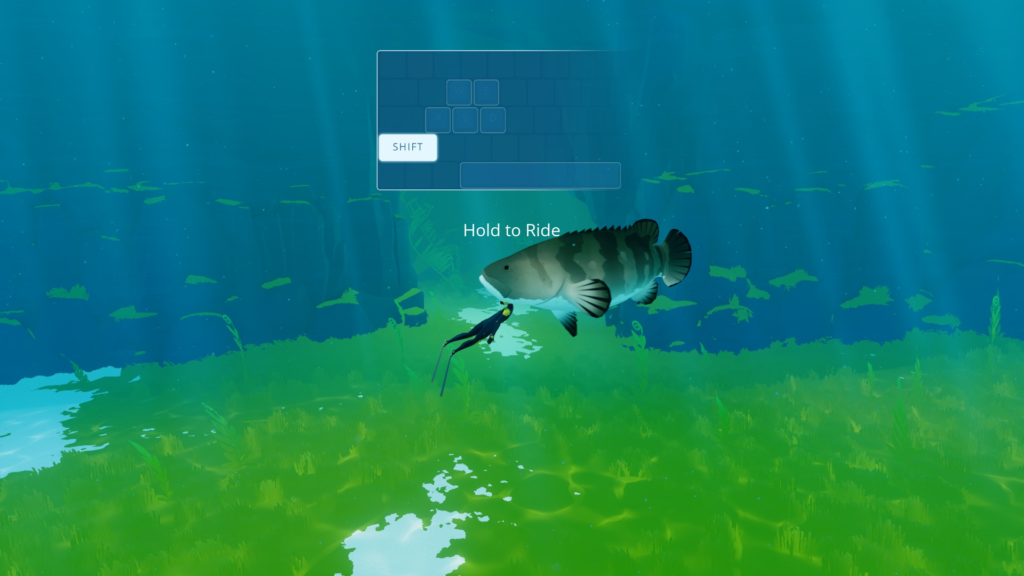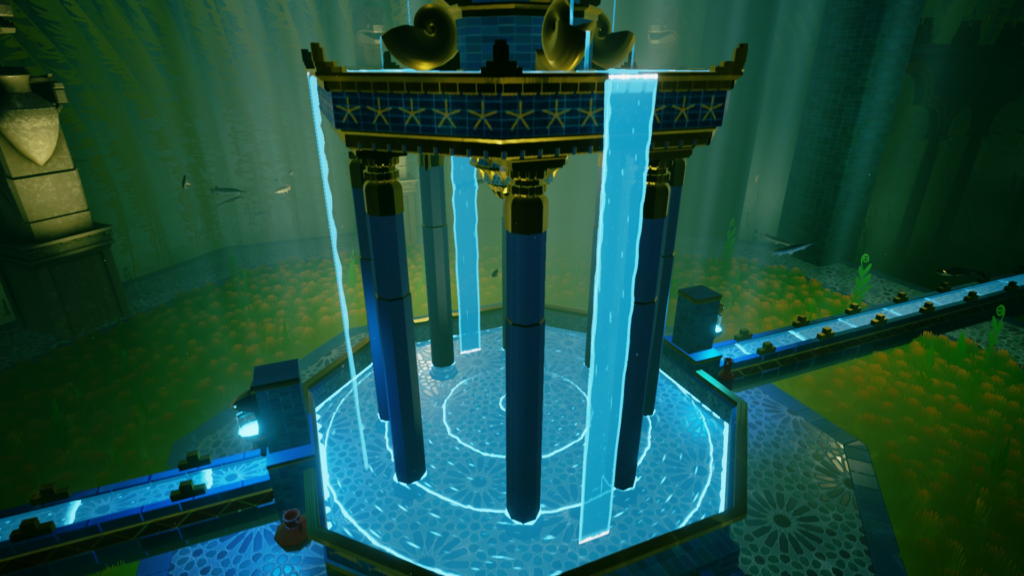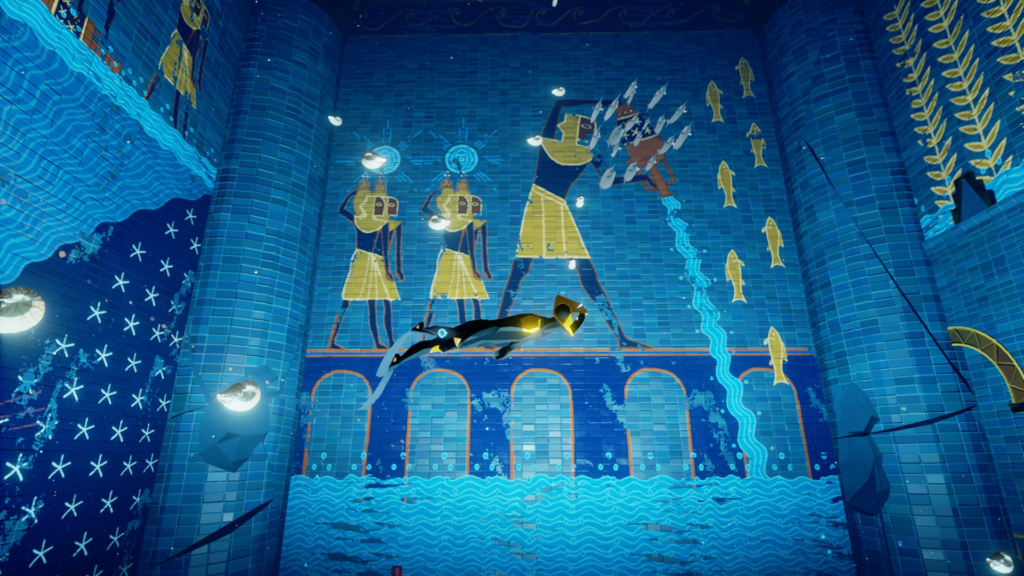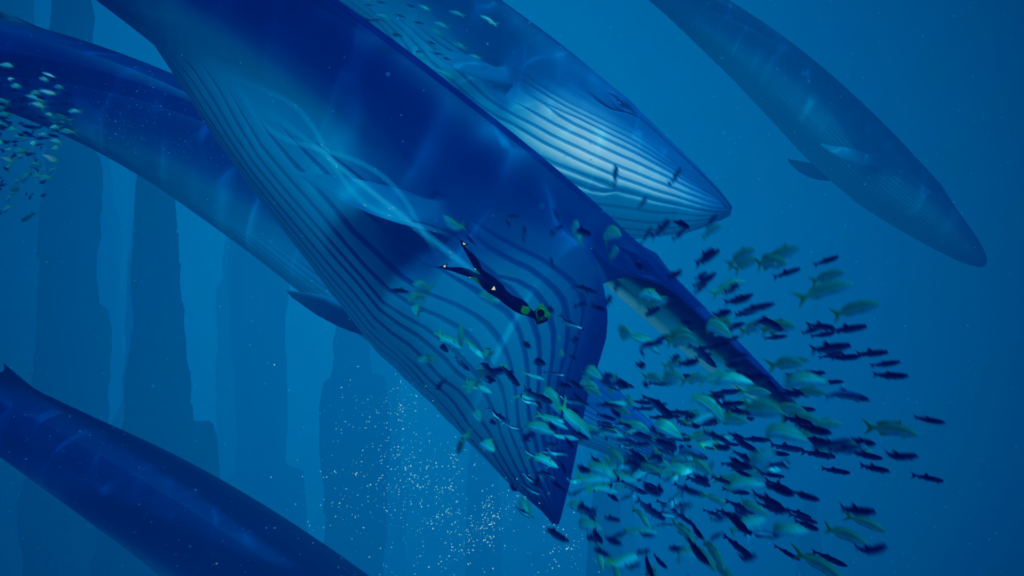For almost as long as video games have existed, it’s been hotly debated as to whether or not they can be art. I feel that in this day and age the question has already been answered. But sometimes you will play something and be forced to ask a different question. Is this even a video game?
1
When you first start playing ABZÛ, you are thrust through the ocean, through shoals of fish, through eddies, through a light in the dark deep of the ocean. We finally rest upon a humanoid creature with a black face and cat-like eyes and ears, floating on the surface. The game then gives us a simple tutorial.

The first time I went scuba diving, I was in awe as soon as dropped below the surface of the water. There is so much life down there that we never even see. I felt this feeling again after I dived in this game. We start off looking at simple blue and white cloudy sky reflected on the blue surface of the water. As soon as we dive we end up in a whole new world, full of fish, underwater vegetation and cave structures.

The controls are intuitive enough that I was swimming smoothly without any kind of guide. I have no idea what my goal is here, but it doesn’t matter. Somehow I find exploring this underwater world to be calming. I don’t need a goal.

I find a cave where I can ride a fish to the next area, so I take it. I am taken to a new area, this one full of underwater plants. Again, I still don’t know what, if anything, I’m supposed to be doing. But I don’t care. This world has beautifully created and I just want to explore every inch of it.

I find a pool I can interact with, and doing so releases some new creatures into the sea. Perhaps this game is about creating life?

I find a small robot that needs to be fixed. When it is repaired it follows me around and allows me to open a coral gate so I can reach a new area.

Sharks roam this area, but they are no threat to us. Through the entire game there are no real threats at all – this game is about exploration and nothing else.

When I think I’m getting a grasp on a game about simple exploration I reach a new area. It’s dark and dull, the plants are black vines fading into the deep. No animals live here, the places feels void of all life. Only a small glowing pool can be seen in the distance.

I swim to the pool and we are pulled into another world where we swim above the water. It appears to be a temple of sorts, with one obvious place for us to swim toward. We do so and our main character appears to give it a piece of their soul.

We are returned to the dark ocean and it explodes with life. Plants spring up everywhere, and animals swim up to their new home. A second, brighter layer of water floats up to the temple as colours fill the cave. A new door opens, showing us where we need to go next. I take my time to explore instead.

We continue through a ruined temple, images, pictograms, and what could be hieroglyphs cover the walls here. These are perhaps leaving a hint to the meaning of all this.

On the other side of the temple we enter a wide open area that is so deep it is terrifying. Despite life being here, you feel small and lonely in the overwhelming ocean here.

The obvious place to go next is a large triangular door. We can activate it using sound to open it. We swim into it, and the screen fades to black – the first level complete.

2
Is this a game? While it is interactive, it doesn’t come with any real challenge. There is little that could be called gameplay. As we progress through each area we get to see more of the world, and slowly piece together what it all means.

We do control a character. We do have to figure out where to go next. There are a couple of simple puzzles where you need to find a switch or two. If Where’s Wally is a puzzle, and Hide and Seek is a game, it’s hard to argue that this isn’t gameplay.

And yet, somehow I find myself thinking that this is more a work of interactive art than it is a game. When I play this game I want to explore more than I want to face a challenge. The game has clearly been designed this way – it even has a feature where you can meditate and follow sea creatures around the world.

Exploration is a form of play, however, so how does that make this “not a game?” I think I could keep talking in circles over and over, but the truth is that it doesn’t matter. ABZÛ is art. ABZÛ isn’t art. ABZÛ is a video game. ABZÛ isn’t a video game. All of these statements are true for a certain definition of “true”.

ABZÛ is beautiful. ABZÛ is calming. ABZÛ is a story.
3
“There was Apsû, the first in order, their begetter,
And demiurge Tia-mat, who gave birth to them all;
They had mingled their waters together”
The game’s story is based on the Enuma Elish, the Babylonian Epic of Creation. It is one of the oldest stories in the world, and describes the creation of the gods, the universe and humanity.

In the beginning of the myth, there is only water swirling in chaos. The water was divided into two, each part becoming gods. Apsu, the sweet freshwater, and Tiamat, the salty bitter water. These gods would then give birth to other gods who then, after a fair amount of conflict and the death of Apsu, go on to create humans.

The creation myth in the game is revealed to us as we visit the various crumbling temples. It’s story is left to interpretation, however. While it has it’s roots in the Enuma Elish, it seems to tell a different story. We discover that there was once a race of people that worshipped the freshwater and used it for many things.

Eventually they used it to develop weapons and their civilisation was destroyed. Our quest seems to be to restore balance to the ocean by destroying the technological pyramids that now drain life from the ocean.

The decayed underwater ruins are all that is left of the old civilisation. We may not be able to restore them, but at the least we can allow life to return to the ocean.

But then, this is only my personal interpretation of the story. Like any true work of art, it is open to interpretation.




